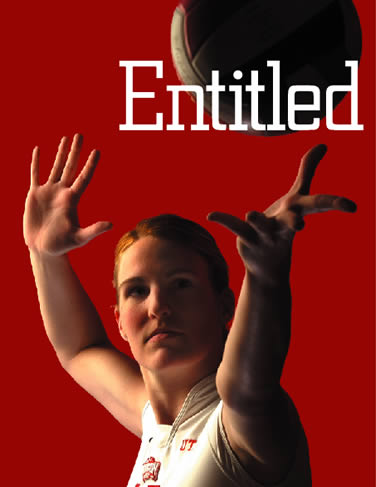| Vol.
13. No. 1 |
Summer
2003 |
|
Kim
Turner |
 Sheri Esrock 2002 best overall doubles record (with Linn Ronnberg) Junior, finance and accounting double major Hometown: Johannesburg, South Africa |
 |
Funny how now, more than three decades after its implementation, controversy
still dogs Title IX, the 1972 amendment that requires schools receiving
federal funds to offer equal opportunities to men and women.
Funny, too, that the University of Utah seems to be above most of the
Title IX fray, earning respect among even its critics as one of the best
schools in the country in terms of negotiating and administering the sometimes-murky
Title IX waters as they apply to athletics.
“Title IX is here to stay,” says Chris Hill, athletic director
and special assistant to the president, adding that the success—or
failure—of an athletic program’s implementation of the law
rides mostly on the backs of its staff, coaches, athletes, and managers.
Indeed, Title IX remains at the center of national debate. The Bush Administration
(via the Department of Education) is expected to enact new regulations
sometime in 2003 that will better ensure true equity among the genders
at major learning institutions while addressing some of the faults programs
have identified under Title IX.
|
|
And critics on both sides of the issue do seem to find fault: some say
that Title IX has promoted the advance of women’s sports at the
expense of men’s by limiting the number of scholarships and general
funding available and in effect dismantling the existence of some men’s
programs. (Examples abound; some are noted below.) Others say Title IX
doesn’t go far enough, that men’s scholarships still far out-number
women’s. (At the University of Utah, 225 full scholarships were
awarded in 2001-02. Of those, 131 were awarded to male athletes).
At the crux of the controversy is an often-mentioned practice: legally
bound to adhere to Title IX regulations, schools have cut men’s
programs to try to provide balance in their athletic department rather
than develop more opportunities for women, which was the original intent
of the law. In those cases, Inevitably, Title IX has been blamed.
But both Hill and Amy Hackett, associate director of athletics, say managing
the law on individual campuses is the key. “I don’t think
that Title IX has diminished men’s opportunities,” says Hackett.
“Institutions make those choices based on the resources they have—or
don’t have—in other areas.” To date, the University
has managed resources effectively, as demonstrated by its top 20 ranking
on the 2002 “Honor Roll of College Sports” by U.S. News and
World Report, based on gender equity, win/loss records, number of sports
offered, and graduation rate.
Hill is proud of the acknowledgment, which he says demonstrates his staff
’s hard work and vision. The athletic department has gone to great
lengths to promote the progress and success of women’s sports while
being sure to maintain the revenue-generating programs—football
and men’s basketball.
Larry Gerlach, longtime U of U history professor, sports historian, and
the school’s NCAA faculty athletic representative, agrees. “Yes,
[Title IX] has been particularly good at the U,” he says.
 |
Tessa
Greegor Utah record in 100-meter breaststroke Sophomore, environmental studies major Hometown: Boise, ID |
But the Utes, like so many comparable programs on a nationwide basis, also face the realities of budgets and dollars. “The model for funding [at university athletic departments] is still based in large part on revenue generated from football and men’s basketball,” Hill says. “That hasn’t changed on most campuses since Title IX became a law.”
Indeed, it’s assumed that the football field is where the bills are paid. But many colleges (particularly smaller programs) actually lose money on football. And without a football team to rely upon, athletic departments are forced to turn to other avenues for monetary support.
“Football does not fund other sports,” Gerlach says of the
general football misconception. “It is profitable in no more than
400-some schools, and is a financial drain for most schools.”
But at the U, Hill says that football drives support of the other sports—despite
attendance challenges and the higher expenses that go into running a typical
program, and despite the success men’s and women’s basketball
and women’s gymnastics have achieved over the years.
That’s why the Utes have taken great measures to rejuvenate interest
in their so-so football team: the program’s revenue- generating
potential, through television monies, donor contributions, and recruit
exposure, is great. And that’s also why the U’s football program
accounts for most of the men’s scholarships—82 of the 131
in 2001-02 (three short of foot-ball’s allotment of 85).
“Most of our programs do not generate income to support scholarships,
so we rely heavily on football and men’s basketball,” says
Frank Dolce BS’93, Crimson Club director of development and former
Utah football quarterback. “We don’t favor these programs
per se, but without them we would be looking at a much different athletics
department at the U.”
“From our standpoint, I think it’s clear that we are excited about all of our sports,” Hill says of any lingering challenges about administering Title IX. “It really isn’t an issue on our campus.” That may be best exemplified by the balance Utah offers—nine men’s programs, and 10 women’s.
|
Recent
Highlights |
Schools can demonstrate their Title IX compliance by having an equal
ratio of female athletes to female students; demonstrating their support
by accommodating female athletes’ interest; and/or showing an ongoing
level of support by providing opportunities for women.
The Utes get passing grades on all three criteria. The U, for example,
introduced the women’s soccer program in 1995-96 in order to keep
up with Title IX regulations (based on recommendations made by a Gender
Equity Task Force formed by the University). Notably, Utah has not added
a soccer counterpart on the men’s side, though the growing popularity
of soccer as a sport and the large number of children of both genders
who participate in leagues were driving reasons behind the women’s
team inception.
Adding another men’s team— wrestling was considered a possibility
at one point—is unlikely in the near future. The Utes’ athletic
demographics and makeup are within five percent of the male-female undergraduate
ratio. As Gerlach points out, “Our female enrollment percentage,
historically about 45 percent, is low compared with other state universities.”
At the U, Title IX was largely the reason the women’s gymnastics
program was launched in the early ’70s, and the team and its coach
have created a 30-year winning legacy. Women’s softball and basketball
have had similar (if not national championship-caliber) success, gradually
including the development of marketing programs, new facilities, and attention
to proper staffing and recruitment.
“There is a high price tag in operating collegiate athletic programs
at this level,” says Hackett. “You tend to put your resources
into [teams] that demonstrate a need for those resources. You want to
reward programs that have been successful and build on that success.”
Still, disparities do remain. Recruiting and travel budgets are sometimes
less for the women than the men, especially in the so-called “minor”
sports. And coaches of women’s sports can receive significantly
lower salaries than their counterparts on the men’s side, even if
the disproportionately higher paychecks that typically go to football
and men’s basketball head coaches are discounted.
But critics admit it’s slowly gotten better over the years, much
to the credit of Hill and his staff, and to the U’s vision over
three decades. “We are fortunate in that we have been able to grow
our women’s sports without hurting the men’s side of things,”
Hill says. “The value of participation in sports is clear for both
men and women.”
|
—Amy Hackett, associate athletic director |
“There are always areas for continued improvement, of course,”
adds Hackett. “But success breeds success. And our women’s
programs—including gymnastics, basketball, softball, and soccer
in the past couple of years—have experienced great success. That
gives you more motivation to continue to grow and reward those programs.”
In short, then, if the football and men’s basketball teams are successful,
and if the other teams are well managed, universities across the country
seem to be able to provide opportunities for both men and women who are
interested in participating in non-revenue-generating sports, regardless
of Title IX restrictions.
And the oft-quoted stories about UCLA and Miami pulling the plug on their
men’s swim teams, Providence College dumping its baseball team,
and—closer to home—Colorado State canning its men’s
baseball and women’s softball teams a decade ago seem to be more
issues of athletic department (mis-) management than Title IX adherence.
“On the whole Title IX is a great success,” Gerlach says.
“The dropping of men’s sports has more to do with [programming]
decisions and finance allocations than being necessitated by Title IX.”
That, too, makes a difference. One factor not all universities enjoy
is what could be considered a bonus at Utah—that is, the women’s
gymnastics, softball, and basketball teams have been successful. They
may not generate the most money in the athletic department, but their
winning records and relative fan interest help them pay the freight. Gymnastics,
in particular, which averages nearly 10,000 fans per home meet, is a tremendous
asset to the athletic program overall.
“I like the parity [between men and women at the U], and our women’s
programs have been terrific,” Dolce says. The facts do seem to bear
a case on behalf of Title IX. While a report released in early 2003 by
the Commission on Opportunity in Athletics confirms the anecdotal evidence
that men still participate in collegiate sports at a higher rate than
women (59 percent to 41 percent) and receive more athletic scholarships
than women (57 to 43 percent), it also confirms the sheer growth in women’s
collegiate sports across the country.
For every one UCLA men’s swim team or Boston University football
program (two of the almost 400 male teams that have been eliminated in
the past three decades), almost 10 new women’s teams have been implemented
(for a total of 3,800 new women’s pro-grams). That number comprises
more than 846 women’s soccer teams, including the one at the U.
According to NCAA statistics, only 16,000 women participated in collegiate
sports in the late ’60s. Today, nearly 10 times that number of female
athletes are on the playing field. The numbers may never quite be truly
“equal.” There may always be a disparity in terms of participating
men and participating women. But the basic concept behind the law’s
impact is not to be denied: it has clearly made a positive impact on opportunities
for women in sports at collegiate programs across the country. When managed
properly, Title IX and its attendant requirements and regulations have
only strengthened the overall appeal of athletic programs and solidified
gender equity and equal opportunities.
Or at least it’s been that way at Utah.
“I understand both sides of the argument and I don’t think
there is an easy answer. With or without Title IX, we have a controversy
on our hands,” Dolce says. “But Title IX has been great for
the U.”
And the U has been great for Title IX.
Funny thing.
—John Youngren BA’88 is a frequent contributor to Continuum.


